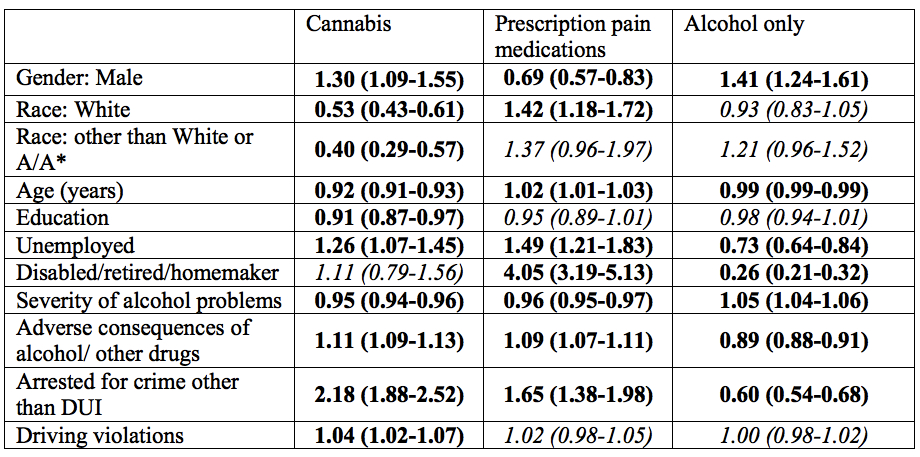STASH, Vol. 10(13) – Correlates of drunk and drugged driving
During the past three decades, public health campaigns have helped reduce the rate of drunk driving. At the same time, however, rates of drugged driving—driving under the influence of drugs other than alcohol—have risen (Kelly, Darke, & Ross, 2004). In response, researchers have begun to expand the study of driving under the influence (DUI). This week, as part of our Special Series on Driving Under the Influence of Intoxicants, we review a study that examined characteristics of people convicted of first-time DUI, including their use of a wide range of substances on the day of their arrest (Pilkinton, Robertson, & McCluskey, 2013).
Methods
- The Mississippi Alcohol Safety Education Program (MASEP), a court-mandated intervention for people convicted of first-offense DUI, served as the setting for this study.
- Participants completed measures of demographic characteristics, alcohol and drug use, substance use problems, and history of other criminal or traffic offenses, and they reported the substance(s) used on the day of their arrest.
- The researchers used binary logistic regression to study the association between participant characteristics and use of several substances on the day of arrest, with one model for each substance category. Here, we focus on cannabis, prescription pain medications, and alcohol.
- The researchers analyzed data from 6,339 participants. This group represents 75.7% of all offenders enrolled in MASEP during the window of observation.1
Results
- Alcohol was the most commonly reported substance, cited as the substance used on the day of arrest by 83.1% of DUI offenders. The second most common substance was cannabis (18.8%), followed by prescription medications for blood pressure, seizures, and nausea (17.4%) and prescription sedatives (16.9%).
- As Table 1 indicates, the researchers observed a number of common and distinct correlates of substances used on the day of DUI arrest. Examples include the following:
- Using cannabis and using prescription pain medications were both associated with reporting less severe alcohol problems but more adverse consequences of all substance use. This pattern was reversed among people who used alcohol on the day of their arrest.
- Only cannabis use had unique predictors: being African American, being less well educated, and having prior driving violations.
- Cannabis and prescription pain medication use were associated with being unemployed and having been arrested for something other than DUI; alcohol use was associated with opposite trends.
- It was never the case that the predictors were the same for all three substances.

Figure. Odds ratios (95% confidence intervals) in models predicting use of cannabis, prescription pain medication, or alcohol only on the day of arrest. Adapted from Pilkinton et al. (2013). Bolded entries represent statistically significant effects; italicized entries represent non-significant effects. *A/A = African American. This category included Hispanic, Native American, and Asian. Click image to enlarge.
Limitations
- The researchers did not measure co-occurring mental health conditions, such as depression and anxiety, which occur often among DUI offenders. It would be helpful to explore how the prevalence of mental health disorders varies among people who have driven under the influence of different drugs.
- This study sampled people who had been arrested for DUI, which is only a subset of people who have driven under the influence. Differential enforcement of DUI laws—for example, according to race or ethnicity—might skew observed patterns.
- These findings are specific to participants who attended this DUI program and might not be representative of other DUI offenders.
Conclusion
Considering DUI as a condition to be treated—rather than simply as an offense to be punished—could prove helpful in minimizing this harmful behavior. If researchers identify personal characteristics associated with driving under the influence of particular substances, they could inform the development of more targeted, and hopefully more successful, prevention campaigns. These results are a preliminary step in this direction. For example, they suggest that campaigns to reduce driving under the influence of marijuana should target relatively young people, and substance use treatment or criminal justice interactions might be effective messages for spreading this message. On the other hand, employee assistance programs might be more effective outlets for messages about driving under the influence of alcohol. More research is needed to translate these findings into public health action.
– Heather Gray
What do you think? Please use the comment link below to provide feedback on this article.
Reference
Pilkinton, M. W., Robertson, A., & McCluskey, D. L. (2013). Drugged driving: Increased traffic risks involving licit and illicit substances. Journal of Drug Education, 43, 183-201.
________________
[1] The remaining participants did not complete study measures or denied using any substance on the day of their arrest